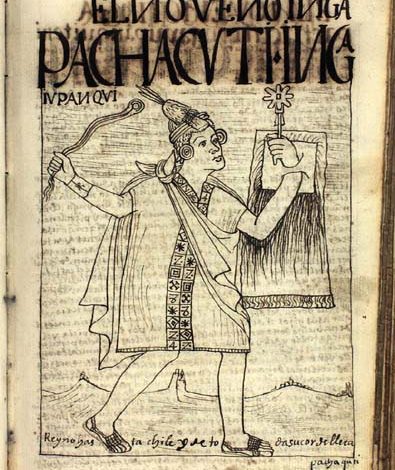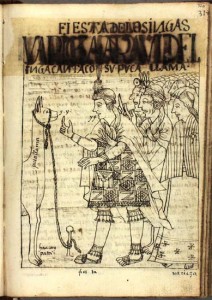Warachikuy Staged Today by Sacsayhuaman

Cuzco’s historical Warachikuy, coming of age ceremony, will be staged by the National Ciencias School for the public today. One of the most recognized schools within the city, Ciencias—Sciences, as it is generally called, frames the event as an “evocation and re-portrayal of the Inca feast of national identity”. Not only does it involve the recreation of ritual, it also portrays the capacity, strength, and abilities of Cuzco’s youth.
After the conquest, chroniclers from Garcilaso on have been fascinated with the Warachikuy, also spelled Huarachicuy, because of its intense demands on the Inca youth. Since in the context of Tawantinsuyo, the Inca Empire, the word Inca meant people with power and brilliance, the ability to keep society and the seasons going, these youth were by definition of the nobility.
Of course the chroniclers and other writers, as well as the current dramatization, give weight to boys, following the emphasis on men of the Europeans, the Incas had demanding coming of age rituals for both men and women. During the Warachikuy, alone, girls played important roles along with the boys; the Incas focused on the complementarity of the sexes, their mutual dependence and difference as cosmological principle, like the sun forever chasing the moon.
On its webpage, Ciencias School states clearly how they, in twenty-first century Cuzco, give importance to the Warachikuy within the ideology of our days.
“In our times, the Inca feast of Warachikuy could be interpreted as more than a kind of Olympics, more than a kind of Olympics of youth, since it did not only hold a highly demanding and exhausting competitive event, it also ranked and discriminated winners from losers, defining in this way the social status to which citizens should belong according to their physical and intellectual capacity.”

The School also locates the event within a pedagogy that emphasizes intercultural learning and value at the same time it promotes entrepreneurial creativity. It sees the event as demonstrating three moments: 1, ritual or ceremonial; 2, competitive and warrior-like; 3, festivity of expressions of war dances. The Inca warrior, as a young man coming of age and overcoming all tests and difficulties, stands as the image Ciencias wishes to promote as a model for Peruvian youth.
Portrayed in six parts, the Warachikuy will be held today on the esplanade of Sacsayhuaman.
The first part is the movement of the youths and the Imperial armies of the four quarters to the esplanade of Sacsayhuaman led by the Qollana, the military chief. They will come from the Plaza San Francisco, the Plaza de Armas, the Qorikancha, and Rimaqpampa representing the four classical sectors of the Empire.
The second part is called the Qhaswa Tusuy, using the word qhashwa, which is widely understood to be a dance (tusuy) of struggle and courtship. Ciencias translates it as a celebration, jubilation, and fiesta. On the esplanade of Sacsayhuaman students from the primary school of Ciencias who won during the Traditional Anniversary Parade of the 20th of August, will present folkloric dances from Cuzco as a prelude to the arrival of the imperial armies and the youths who will undergo the ritual competition. Its purpose is to prime the audience for the coming segments.
The third part is the arrival of the Imperial army along with a ritual of offerings. This includes the Much’ay–a worshipful salute to the Sun God (Much’ay was a kissing movement of the lips along with other reverential motions, since the verb means to kiss and came to stand for the European idea of “worship” during the early years of the Spanish colonies), the offering of chicha—corn beer, the Llama T’ikallasqa—the flowering of the llama, and the rite of fire.

The fourth part portrays the competitions Inca youths underwent. For the purposes of this drama they include the Amaru war dance, ch’aski marathon called watamanta or the fastest “messenger” of the year, a speed test with obstacles, strength testing, the Kuntur (condor) war dance, resistance testing, balance testing, the k’achapampa dance, difficulty testing, drisk testing, the puma tusuy dance, testing of good aim, and the Mishawas war dance.
The fifth part displays the two halves of Cuzco in a ritual battle. Hanan Qosqo (Upper Cuzco grapples with Hurin Qosqo (lower Cuzco) . The perform body to body combat and then use traditional slings (warak’as) to throw projectiles from a distance. The battle comes to an end when the Inca declares peace. Traditionally ritual battles among the halves of communities showed the importance of tension and difference as a principle of the organization of society and the cosmos.
The sixth part of the festivity is the “solemn act of graduation”.
In order to carry out the staging of the Warachikuy, participants have been rehearsing for weeks. The School of Ciences divided up it students to represent youths from Cuzco’s four quarters as well as the Inca warriors. Since Ciencias is a school for boys, it invited it partner Educandas, a school for girls, to perform with them.
The performance is demanding. To the sound of quenas (traditional flutes) and bombos (traditional drums) the students march forward.
Even small children participate. They will present a war dance as a test of their valor. The whole community of the two schools comes together to carry out this feast of Warachkuy.
The drama is performed every year on the third Sunday of September. Sunday was chosen so that entire families could come to the esplanade to watch the performance and share the celebration with young and old.
The feast is also recognized by Cuzco’s authorities who watch over the national patrimony and guarantee services of security and hygiene. To appreciate this portrayal of an Inca event that, in its original form, covered much of the valley in which contemporary Cuzco lies, you will need to arrive early at Sacsayhuaman.
Note: the pictures come from the following places.
First picture
http://www.kb.dk/permalink/2006/poma/320/en/text/?open=id2974799
Second picture
http://www.kb.dk/permalink/2006/poma/108/en/text/?open=id2970453




